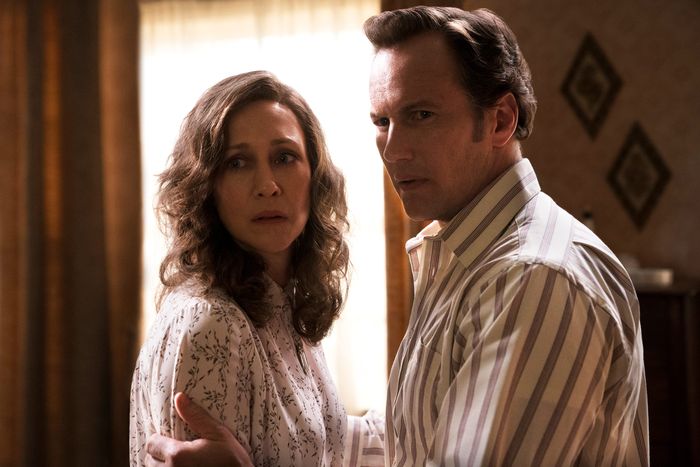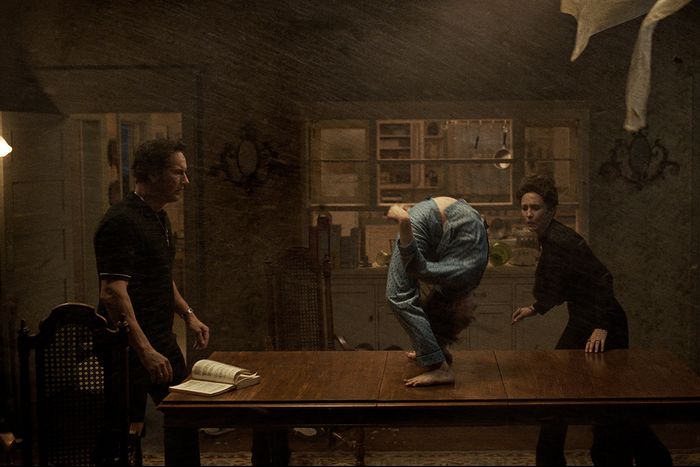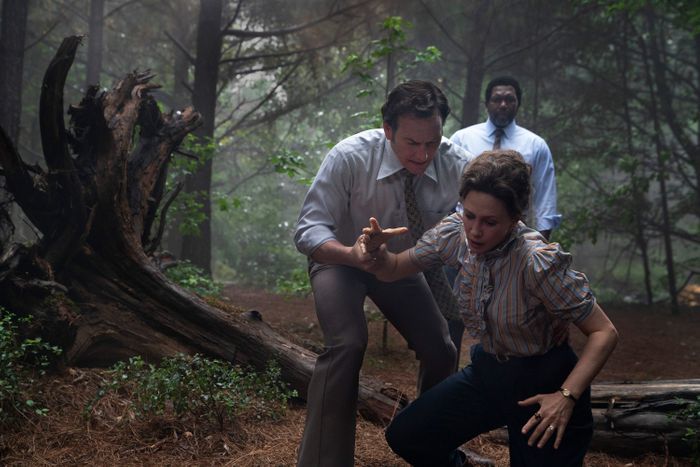
Early in The Conjuring: The Devil Made Me Do It, Lorraine Warren (Vera Farmiga) offers her husband, Ed (Patrick Wilson), a warm drink and a “hon, are you feeling alright?” It’s a small moment as they prepare for a violent exorcism, so it’s easy to miss, but it’s an overwhelmingly tender beat. As in the first two Conjuring films, the couple is in sync enough to know that something is wrong even before it happens. Lorraine is clairvoyant, but their connection runs deeper than that.
The rhythms of the scene should be familiar to fans of the Conjuring universe, a horror franchise from Warner Bros.’ New Line Cinema, Peter Safran, and James Wan (Saw, Insidious). Soft moments between the two paranormal investigators are peppered throughout the first two movies, and The Conjuring: The Devil Made Me Do It is no exception. In theaters and on HBO Max on June 4, the film follows Ed and Lorraine Warren at the dawn of the Satanic Panic as they investigate the case of Arne Cheyenne Johnson (Ruairi O’Connor), the first recorded person in the U.S. to plead not guilty to murder charges by reason of demonic possession.
After earning more than $1.9 billion at the worldwide box office, the Conjuring universe is officially one of the highest-grossing horror franchises of all time and reigns supreme in the supernatural subgenre. The intense demonic possessions and jump-scare mirror tricks have aided in the rise of the films, but the franchise’s greatest asset — what separates The Conjuring from similar movies and keeps it at the height of the horror genre — is that it remains fundamentally grounded in the love story between the Ed and Lorraine characters.
“The love between them, whether people want to admit it or not, I think that’s a big reason why people keep coming back,” Wilson tells Vulture in a joint interview with Farmiga.
“It’s what makes the franchise so, so unique and sets it apart,” Farmiga adds. “There’s just something so wonderfully soothing about the love-story aspect that balances out the terror and the fear and the horror.”
The Devil Made Me Do It marks the duo’s third Conjuring and fourth overall film as Ed and Lorraine, so they’ve become familiar with the inner workings of the franchise after living within it for the better part of a decade. Both actors are staples of the horror genre, with Wilson starring in Insidious and Farmiga at the helm of Orphan and the Bates Motel TV series.
“Certainly if you come into a horror movie, you know you want to be scared or freaked out … whatever it is that people love about the communal atmosphere of a horror film,” Wilson says. “But these films give you so much more because you start to really care about this couple and this family.”
“It is a story about love,” Farmiga explains. “It’s love for each other. It’s love for their higher power. Love for what they do. Love for the people that they try to help. There’s so much love to display.”
Viewers first meet the Warrens in The Conjuring (2013) in 1971 after they bring the infamous Annabelle doll back to their Connecticut home, where they keep it locked in an artifact room with other haunted objects. When they’re not working active cases as demonologists and consulting with the Catholic Church, they’re lecturing about the paranormal at universities. With Lorraine’s clairvoyance comes the occasional devastatingly personal insight, which recently shook her to her core during an exorcism. Ed worries about her and suggests that they take a break from their research.
Meanwhile, in Rhode Island, Roger (Ron Livingston) and Carolyn Perron (Lili Taylor) move into an old house with their five daughters. Immediately, things start to go bump in the night. The mother keeps waking up with strange bruises on her body. The clocks stop at the same time every night and the house often smells like rancid meat. The basement, which the family didn’t uncover until after they moved in, is a particular source of concern. The girls play “hide and clap,” a blindfolded hide-and-seek game where players locate each other by clapping. Naturally, the spirits in the house catch on, culminating in one of the creepiest sequences in the entire franchise. It’s not until Carolyn seeks out the Warrens during one of their lectures that the two family’s stories become intertwined.
The film is tender throughout. Ed and Lorraine reach for each other, almost subconsciously, and tend to migrate together during scenes. Where one goes, the other follows. The characters seem to fit together. It’s not a coincidence that his tie often matches her skirt or dress, a trend that continues in all of the movies. They check in on each other frequently. After a particularly grueling night in the house, they hang the Perron family’s laundry together. They embrace and tease moving out to the country together. Their piano theme — a tune from Mark Isham — plays softly in the background, and follows them during quiet moments in each additional movie. As soon as Ed walks away, Lorraine loses hold of one of the sheets and it presses against the outline of an entity. It’s perhaps the greatest example of the franchise’s signature whiplash between romance and horror.
“I think that Patrick and Vera have a great chemistry onscreen,” says Michael Chavez, director of The Conjuring: The Devil Made Me Do It. “That is definitely mined in this film and the previous films. It comes from a great friendship offscreen, and a great respect for each other as actors.”
The rapport is palpable. In conversation, they build off of and defer to one another. When Wilson’s microphone unexpectedly cuts out for a minute, he’s apologetic.
“It’s okay, hon,” Farmiga reassures, before returning to the discussion. She chalks their partnership up to their synergies being “good together.”
The Conjuring 2 (2016) doubles down on the romance in the first film and becomes more personal as viewers learn just what Lorraine saw that had her so spooked. During a séance in Amityville, she comes across a terrifying nun and foresees Ed’s death. This time, Lorraine is the one to request that they take a break from work. Ed acquiesces, until the church calls them overseas to England to look into the Enfield poltergeist of 1977. The Hodgson family is in a crisis when one of the daughters becomes violently possessed by what appears to be a malevolent spirit dwelling in their house.
Ed and Lorraine take turns sharing with the young girl that they understand what it’s like to be an outsider, especially growing up witnessing the paranormal. They tell her that the key was finding someone who believed them. Their full-on belief in one another is one of the more deeply romantic aspects of the series, especially in a genre that often features one character begging another to believe them before it’s too late. In an attempt to cheer up the girl and her siblings, Ed busts out a guitar and performs “Can’t Help Falling in Love.” He sings mostly to Lorraine, who swoons, but her expression turns to one of devastation as she realizes all that she’s about to lose.
“What the movies have done is enable us to, yes, put each other in peril in certain situations, but really at the end of the day it’s always about their love, right?” Wilson says. “So it becomes this idyllic love and I think that’s very hopeful for people.”
Several near-death experiences and a thorough vanquishing of the nun (demonic spirit Valak) later, the Warrens return to New England. The final scene of the sequel initially appears to be in line with the first film as Ed adds to their artifact room. But instead of one of the haunted artifacts creepily churning out a song and a cut to black, familiar music begins to play from the other room. “Can’t Help Falling in Love,” this time sung by Elvis, draws Ed to Lorraine, where she waits for him by their record player. She reaches out for him and the two slow-dance in their living room until the screen fades to black. It’s a shockingly intimate and decidedly un-horrific scene to end on, but it ultimately underscores the franchise’s priorities.
Chavez shares that he, Wan, and the studio definitely leaned into the relationship after realizing that the chemistry was there.
“It’s funny, because I think they really created these characters,” he says, regarding Farmiga and Wilson. “These characters have developed over the course of these three movies. And I think that it wouldn’t probably have become as much of a love story if they didn’t have that chemistry.”
Both actors note that The Conjuring is “not a biopic,” which has allowed them to further make the characters their own.
The real Ed and Lorraine Warren, whose paranormal investigations and books inspire the movies, died in 2006 and 2019, respectively. The latter served as a consultant on the franchise until her death. In 2017, some unsettling claims emerged against the real Ed Warren, alleging that the couple’s relationship might not have been as wholesome as that of their film counterparts’. The allegations arose amid a larger legal battle over the screen rights to the Warrens’ stories, which was settled that same year in the studio’s favor.
The legal troubles haven’t slowed the franchise down. After Annabelle (2014) and Annabelle: Creation (2017), the studio began to mine potential spinoffs from The Conjuring 2. Valak received an origin story in the form of 2018’s The Nun, which became the franchise’s biggest box-office win and had one of the highest-grossing first weekends in R-rated horror history. The film stars Taissa Farmiga, Vera Farmiga’s younger sister, as a novitiate in 1952 who is sent by the Vatican to investigate a Romanian covenant following the suicide of one of its nuns. A sequel and a film about the “Crooked Man,” another Conjuring 2 byproduct, are reportedly in the works. Annabelle Comes Home (2019) brings Farmiga and Wilson back, although the bulk of the action takes place while the two are away and Annabelle starts to haunt the Warrens’ daughter, Judy (Mckenna Grace), and her babysitter. The Curse of La Llorona, another 2019 release and Chavez’s feature-film directorial debut, fits into the franchise when a widow (Linda Cardellini) and her children seek help from a priest who appeared in Annabelle.
All of the offshoots are at least somewhat tied to the Warrens, even if it’s just a couple of scenes to wrap the mythology together, but the franchise is at its best when the story is focused on Ed and Lorraine. The romance heightens the stakes of the horror, because the characters have made it clear that one cannot live without the other, should something happen to either of them. The best thing about the characters, from the very first film, has never had anything to do with the paranormal — it has always been what they mean to each other. The Conjuring: The Devil Made Me Do It understands this better than any of its predecessors.
The film, which Chavez says he and Wan initially pegged as “Se7en in The Conjuring universe,” opens right in the thick of things. The Warrens are immediately in on the action, rather than the slow haunting of the other Conjuring films, and within the first ten minutes it’s clear that it’s a different type of venture. The plot moves beyond the haunted-house formula perfected in the first two movies and the case quickly proves to be the most dangerous of Ed and Lorraine’s career, with threats beyond just the supernatural.
“There’s so many different flavors in this one,” Chavez says. “Without a doubt, first and foremost, it’s a horror movie. Then we have elements of a thriller. But I think that the love story is incredibly strong.”
Like the first two Conjurings, the film drills down on the fact that love is more than just good, and maybe a form of salvation itself. At the base level, it separates the characters from the demons they’re up against.
“I think that ultimately faith and love — and the faith that we put in each other, the faith that we put in the people that we choose to love — that’s ultimately the story that we’re telling,” Chavez says.
If the romance sets up the potential for some of the franchise’s biggest scares, then the inverse is also true. One of the most enjoyable aspects of The Devil Made Me Do It, and The Conjuring films as a whole, is the rush whenever Ed and Lorraine reunite after barely making it out of a situation. The franchise has perfected its ability to unsettle viewers at their core, but it has also instilled a well-earned expectation of relief. Farmiga offers a simple theory.
“It’s a salve, love, isn’t it? Love is a salve. It’s as simple as that,” she says. “It has a great power to soothe and comfort; it’s inoculation right after you experience such fear. It’s a completely awesome balance.”



